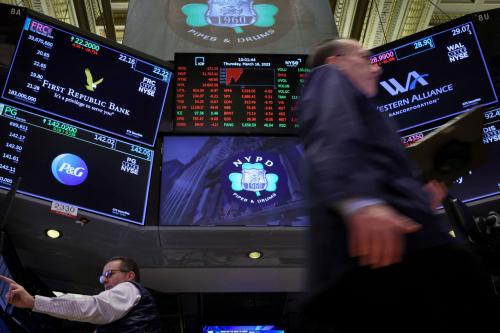In Unpacked, Brookings experts provide analysis of Trump administration policies and news. Subscribe to the Brookings Creative Lab YouTube channel to stay up to date on the latest from Unpacked.
THE ISSUE: On Monday July 9, in the most extensive trade protections in nearly a century, the White House implemented a 25 percent tax on Chinese imports. China retaliated in force with a 25 percent tax on U.S. automobiles and agricultural products, such as soy beans. The tariffs accompanied the ongoing U.S. tariffs on imports of steel, aluminum, washing machines, and solar panels, pushing the countries into an all-out trade war.
“As the U.S. imposes tariffs [on China], half of that pain will be felt by other countries. So, yes, there will definitely be collateral damage, including to U.S. firms that produce and operate in China”
The things you need to know:
- U.S. exports to China are concentrated in agricultural products like soybeans, plus automobiles and Boeing aircraft sales. The trade war is already having an effect on those sectors.
- Locations in the Midwest where they produce soybeans will be affected and farmers are feeling this strongly. The price of soybeans is already down 20 percent.
- The U.S. exports cars from Southern states like Tennessee, so the effects of this change will be felt there.
- Boeing is concentrated in the Northwest but has production in most states, all of which may see the results of these tariffs.
- China’s exports to the United States include technologies like smartphones, computers, and tablets. Such goods are part of “global value chains,” with China at the end of the chain.
- Smartphones come to the U.S. as exports from China even though there are thousands of parts produced and assembled in many countries.
- While China is the final assembler from many products, actually more than half of the value of those products are in parts and components from other countries like South Korea and Japan—so there will definitely be collateral damage from U.S. tariffs.
- The pain from this collateral damage will be felt in many places, including U.S. firms that operate in China.
- It’s hard to see the off-ramp right now. The U.S. has announced $250 billion of tariffs on products from China, and China has partially retaliated and will probably come out with more retaliation.
- For the next several months we will probably be locked into this situation. No high-level negotiations are scheduled.
- The Trump administration sees this as a winning strategy for the midterm elections in 2018. Trump said he would hit China, and now he has.
- This is not a big hit for the overall U.S. economy but it will hurt some specific sectors, like those aforementioned. On the whole this is a minor blip so the Trump administration will probably not change its strategy soon.
- It is unlikely that the Chinese leadership will cave in and do anything major.
- China is willing to buy more products from the U.S. and open more markets, so their offer is clear.
- After the 2018 elections, we’re likely to see the two sides come together and negotiate something so that they can both save face, but it is unlikely that this will be anytime soon.
The sources:




Commentary
Unpacked: The US-China Trade War
July 12, 2018